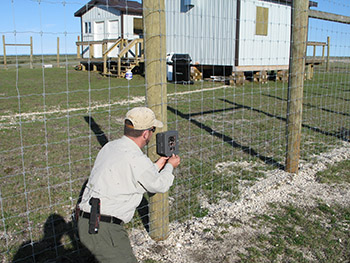
Remote camera images
Wapusk National Park

River multi-use compound.
Fall is polar bear season in northern Manitoba, and throughout October and November, you can check out what’s going on in real time in Wapusk National Park! Every autumn, polar bears gather at Cape Churchill, along the Hudson Bay coast, waiting for the sea ice to form. Polar bears depend on sea ice as a platform from which to hunt ringed seals, their main food source.
Polar Bears International and explore.org have placed webcams at Cape Churchill, in Wapusk National Park. Watch the Cape Churchill cams live.
Frontiers North Adventures is also working with Polar Bears International and explore.org to offer two additional webcams from the Cape Churchill area. Check them out at Tundra Buggy Cam and Tundra Buggy Lodge.
Additionally, Polar Bears International installed a raven camera on Wapusk’s Cape Tower.
These ravens have selected the topside of a radar reflector attached to the Cape Churchill observation tower. Dr. Ian Stirling built this structure to observe polar bear behaviour starting in the 1970s. Since that time, many biologists have called this cabin in the sky home while researching the local wildlife. Now you can also enjoy this same remote vantage point.
This camera is off at night to preserve power.
Polar Bears International (PBI) is a non-profit organization dedicated to the worldwide conservation of the polar bear and its habitat through research, education, and action. PBI provides scientific resources and information on polar bears and their habitat to institutions and the general public worldwide.
explore.org is a philanthropic media organization and multimedia arm of The Annenberg Foundation, as part of its Pearls of the Planet initiative, a variety of live feeds that aim to help people fall in love with the world again.
Frontiers North Adventures specializes in authentic adventures in Canada's North providing guests with the opportunity to experience the wildlife, history, and culture of the people of the north. Owners and operators of the world-famous Tundra Buggy® Adventures, Frontiers North offers a variety of wildlife-viewing programs, the most popular being polar bears in Churchill.
History
Wapusk National Park is a remote, northern place that few people are lucky enough to visit in their lifetime. Fortunately, remote trail cameras provide an opportunity for the world to see the park’s wildlife, undisturbed by the presence of people.
While these cameras have captured amazing photographs which we’re pleased to share here, their main purpose is to help Parks Canada answer important questions about wildlife within Wapusk National Park and how they interact with people.
In 2008-09, Parks Canada built fenced camps at Broad River and at the Owl River delta. They were constructed away from the coastline to minimize the risk of encountering polar bears. Park staff later reported occasional bear sightings and so in 2010 installed trail cameras to see what wildlife was coming to the camps.
In 2011, Parks Canada began working with Dr. Douglas Clark, a professor at the University of Saskatchewan and former Park Warden at Wapusk National Park. More cameras were installed to determine whether the camps were attracting polar bears, and if so, to provide information to help Parks Canada plan for human and bear safety at the camps. These professional-grade trail cameras operate day and night, year-round, and are triggered when their sensors detect moving warm objects. The cameras are bolted to the fence and are protected by heavy-duty steel cases. The flash is infra-red, minimizing disturbance to wildlife at night.

in winter, when cameras often have to be dug out of
snowdrifts.
Soon after installation of these cameras, researchers and park staff realized there was more we could learn from the photos than anyone had originally expected. The cameras are able to document precisely when the bears first come ashore in spring and when they move back onto the sea ice in winter. The images can also show how fat the bears are in any given year, which is an important influence on how many cubs they will have and how well they will survive. Researchers can often determine which bears are visiting the camps: at Nester One research camp, in the northern region of the park, it’s mainly adult males, whereas at the other two camps adult females with cubs are most commonly observed. More information about these research findings can be found in the following paper “Temporal aspects of polar bear occurrences at field camps in Wapusk National Park”.
Parks Canada staff collect the cameras’ memory cards each winter when the park is accessible by snowmobile. Cameras are often buried and must be dug out of snow drifts. The images are then sent to Dr. Clark and his team for research purposes. Images are also shared with Parks Canada to showcase the park and its wildlife to all Canadians.
Besides polar bears, the cameras capture images of a wide variety of animals that Canadians love. Please enjoy this gallery of images the cameras have captured. Be sure to check back soon as this page will be updated with new pictures.

We thank the following institutions for their support of this research:
- University of Saskatchewan
- Social Sciences and Humanities Research Council of Canada
- Churchill Northern Studies Centre, Northern Research Fund
- TUNDRA / Norwegian Research Council
Photo albums
Related links
- Date modified :